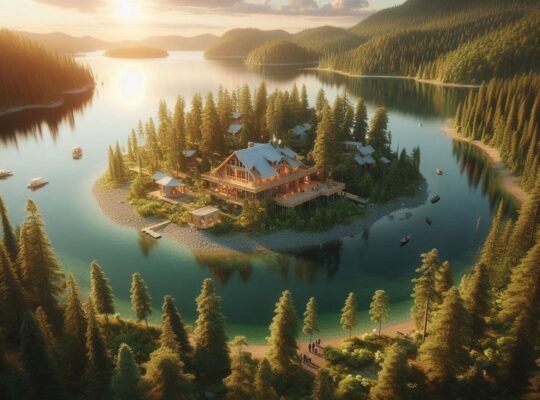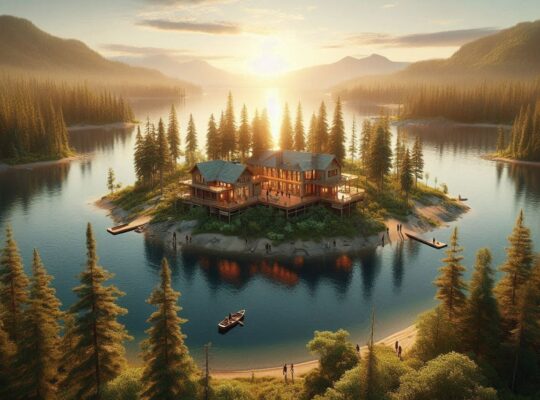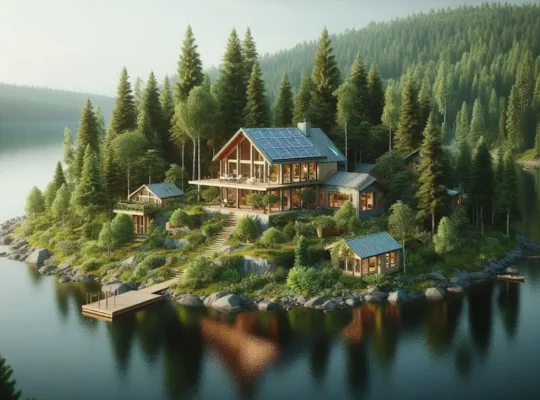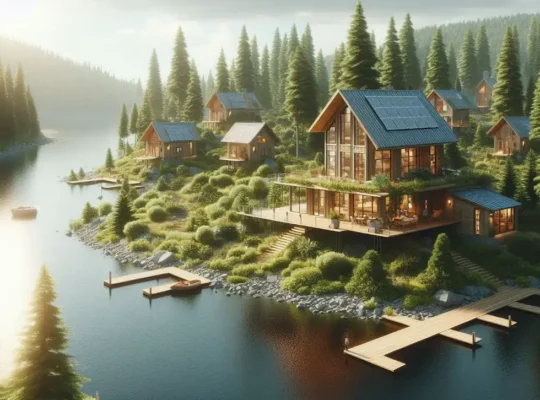Desert Diamonds: The Evolution of Sustainable Villa Architecture
The transformation of Dubai’s luxury villa landscape has been nothing short of remarkable, with sustainability taking center stage in modern architectural designs. The integration of environmental consciousness with opulent living has created a new paradigm in residential development. In 2024, Dubai witnessed a 47% increase in eco-friendly villa projects compared to the previous year, marking a significant shift in real estate development priorities. The implementation of advanced building materials, such as thermally-efficient glass and recycled construction components, has reduced the environmental impact while maintaining the signature luxury associated with Dubai properties. These innovative approaches have resulted in an average reduction of 35% in energy consumption compared to traditional villa designs.
The architectural revolution in Dubai’s villa sector encompasses more than just material selection. Modern sustainable villas incorporate biophilic design principles, seamlessly blending natural elements with contemporary aesthetics. The introduction of vertical gardens and green walls has become increasingly prevalent, with over 60% of new luxury villa projects featuring these elements. These living walls serve multiple purposes, from natural temperature regulation to improving air quality, while creating striking visual features that enhance property values by an average of 15-20%.
The integration of smart home technologies with sustainable features has created a new benchmark in eco-luxury living. Advanced building management systems monitor and optimize energy usage in real-time, resulting in a 40% reduction in utility costs for homeowners. The implementation of Internet of Things (IoT) devices allows for precise control of lighting, temperature, and water usage, further enhancing the ecological footprint of these prestigious properties. These technological innovations have attracted a new generation of environmentally conscious luxury buyers, with market research indicating a 55% increase in demand for smart, sustainable villas among high-net-worth individuals under 45.
The economic implications of sustainable villa development have been equally impressive. Property developers report a 25-30% premium on eco-friendly villas compared to conventional luxury properties, reflecting the growing market appreciation for sustainable living spaces. The long-term cost benefits, including reduced maintenance and utility expenses, have created a compelling value proposition for investors and homeowners alike. This economic success has spurred further innovation in sustainable design, creating a virtuous cycle of environmental and financial benefits.
Harvesting the Sun: Solar Innovation in Desert Dwelling
Dubai’s abundant sunshine has become a cornerstone of sustainable villa design, with sophisticated solar integration systems leading the charge toward energy independence. Contemporary villa developments have embraced cutting-edge photovoltaic technology, incorporating transparent solar panels that serve as both windows and energy generators. These innovative systems can produce up to 40% of a villa’s total energy requirements while maintaining the aesthetic appeal of luxury architecture. The implementation of solar thermal systems for water heating has further reduced energy consumption, with some properties achieving up to 80% reduction in water heating costs.
The evolution of solar storage solutions has revolutionized energy management in eco-friendly villas. Advanced battery systems, capable of storing excess solar energy, ensure continuous power availability while reducing grid dependency by up to 65% during peak consumption periods. The integration of smart grid technology allows homeowners to sell excess energy back to the utility network, creating a new model of sustainable energy economics. This system has resulted in an average annual energy cost savings of AED 45,000 for villa owners.
Recent advancements in solar cooling technology have addressed one of the primary challenges of desert living. Solar-powered absorption chillers provide efficient cooling solutions while reducing electricity consumption by up to 70% compared to conventional air conditioning systems. These systems utilize thermal energy storage, allowing for continuous cooling even during nighttime hours. The implementation of these technologies has significantly enhanced the sustainability profile of luxury villas while maintaining optimal comfort levels throughout the year.
The aesthetic integration of solar technology has evolved considerably, with designers developing innovative ways to incorporate photovoltaic elements into architectural features. Solar canopies and pergolas serve dual purposes as shade structures and power generators, while solar-integrated building materials maintain the luxurious appearance expected in high-end properties. These design innovations have contributed to a 40% increase in property values for villas featuring advanced solar integration.
Water Wisdom: Revolutionary Aqua Conservation Systems
In response to the challenges of desert living, Dubai’s eco-friendly villas have pioneered revolutionary water conservation systems that set new standards in sustainable luxury. Advanced greywater recycling systems capture and treat water from sinks, showers, and appliances, providing up to 65% of the water required for landscape irrigation and non-potable uses. These sophisticated systems incorporate smart filtration technology and UV purification, ensuring safe and efficient water reuse while reducing municipal water consumption by an average of 45%.
The implementation of smart irrigation systems has transformed landscape management in eco-friendly villas. Soil moisture sensors and weather-responsive controllers optimize water usage, resulting in a 50-60% reduction in landscape irrigation requirements. Native and drought-resistant plant species are carefully selected to create stunning gardens that thrive in the desert climate while minimizing water consumption. These landscaping innovations have contributed to the creation of sustainable microenvironments that enhance both property aesthetics and environmental performance.
Atmospheric water generation technology has emerged as a game-changing solution in sustainable villa design. These systems extract moisture from the air, producing up to 400 liters of potable water daily, depending on atmospheric conditions. The integration of solar-powered water generation systems has created a new paradigm in water independence, reducing reliance on municipal water supplies by up to 35%. This technology has proven particularly valuable during peak summer months when water demand is highest.
Smart home water management systems provide real-time monitoring and control of water usage throughout the property. Leak detection sensors and automated shut-off valves prevent water waste and potential damage, while usage analytics help homeowners optimize their consumption patterns. These systems have demonstrated average water savings of 30-40% compared to traditional luxury villas, resulting in significant cost reductions and environmental benefits.
Living Walls: Vertical Gardens Reimagined
The integration of vertical gardens in Dubai’s eco-friendly villas has evolved beyond simple aesthetics to become a crucial component of sustainable design. Advanced hydroponic systems support lush vegetation while consuming 90% less water than traditional gardening methods. These living walls incorporate carefully selected plant species that thrive in the local climate while providing natural cooling through evapotranspiration. Temperature measurements indicate that areas adjacent to living walls experience temperature reductions of up to 5°C compared to bare walls.
The implementation of smart monitoring systems ensures optimal plant health and resource efficiency in vertical gardens. Automated nutrient delivery systems and climate control maintain ideal growing conditions while minimizing maintenance requirements. These systems operate in conjunction with the villa’s overall building management system, optimizing water and energy usage based on environmental conditions and occupancy patterns. The integration of LED grow lights, powered by solar energy, ensures consistent plant growth throughout the year.
Recent innovations in vertical garden design have introduced modular systems that allow for easy maintenance and plant replacement. These systems incorporate drought-resistant species and native plants that contribute to local biodiversity while requiring minimal care. The structural design of modern living walls includes dedicated maintenance access points and automated cleaning systems, reducing the long-term costs associated with upkeep. These practical considerations have made vertical gardens an increasingly attractive feature for luxury homeowners.
The environmental impact of vertical gardens extends beyond their immediate aesthetic and cooling benefits. Research indicates that living walls in Dubai’s eco-friendly villas can capture up to 40 kg of dust particles annually per square meter, significantly improving air quality. The presence of extensive vertical gardens has been linked to increased property values, with market analysis showing a 12-15% premium for villas featuring well-maintained living wall systems.
Smart Integration: The Neural Network of Eco-Luxury
The technological backbone of Dubai’s eco-friendly villas represents a quantum leap in smart home integration, with artificial intelligence driving unprecedented levels of efficiency and comfort. Advanced neural networks analyze patterns in energy consumption, water usage, and occupant behavior to optimize resource allocation in real-time. These systems have demonstrated the ability to reduce overall energy consumption by up to 45% compared to traditional smart home systems, while maintaining or enhancing occupant comfort levels.
The integration of predictive maintenance algorithms has revolutionized property management in sustainable villas. AI-powered systems monitor equipment performance and environmental conditions, identifying potential issues before they become problems. This proactive approach has reduced maintenance costs by an average of 35% while extending the lifespan of critical systems. The implementation of digital twins allows for virtual simulation and optimization of building systems, ensuring peak performance under varying conditions.
Biometric security systems and personalized environmental controls create a seamless living experience while maintaining high levels of security and privacy. Advanced facial recognition and behavioral analysis systems provide customized responses to individual occupants, adjusting lighting, temperature, and other environmental parameters based on learned preferences. These systems integrate with sustainable features such as automated natural ventilation and dynamic solar shading to optimize comfort while minimizing energy consumption.
The development of dedicated mobile applications provides homeowners with unprecedented control and visibility over their property’s sustainable features. Real-time monitoring of energy production, water usage, and system performance allows for informed decision-making and optimization of resource consumption. These applications also facilitate community engagement, enabling villa owners to compare performance metrics and share best practices in sustainable living.
Environmental Integration: Harmonizing with Nature
The design philosophy of Dubai’s eco-friendly villas extends beyond individual properties to create harmonious relationships with the surrounding environment. Careful consideration of solar orientation and prevailing wind patterns influences architectural decisions, maximizing natural ventilation and minimizing heat gain. The implementation of green corridors and wildlife-friendly landscaping has resulted in a 60% increase in local biodiversity within sustainable villa communities.
Advanced building envelope systems incorporate phase-change materials and dynamic insulation properties, adapting to environmental conditions to maintain optimal indoor comfort. These innovative materials can reduce cooling loads by up to 35% during peak summer months while providing effective thermal management throughout the year. The integration of natural ventilation systems, including wind towers and thermal chimneys, harnesses traditional architectural wisdom while incorporating modern technology.
The creation of sustainable microclimates around eco-friendly villas has demonstrated remarkable success in moderating local temperatures. Careful placement of water features, vegetation, and shade structures creates cooling effects that extend beyond individual properties. Temperature measurements indicate that well-designed sustainable villa communities can maintain temperatures 3-4°C lower than surrounding urban areas, contributing to reduced energy consumption and improved outdoor comfort.
The implementation of permeable paving systems and rainwater harvesting infrastructure helps manage occasional heavy rainfall events while replenishing groundwater resources. These systems can capture and filter up to 95% of precipitation, reducing runoff and potential flooding risks. The integration of sustainable drainage solutions with landscape design creates functional and aesthetic features that enhance property values while supporting environmental goals.






